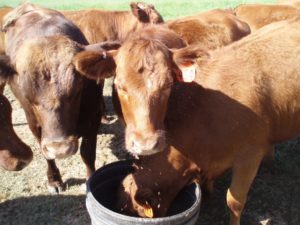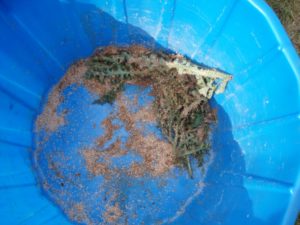As part of the Foundation’s effort to be proactive and innovative in the application of management practices, we volunteered to

participate in a trial weed control method brought to Madison County by the NRCS, Madison Valley Ranchlands Weed Committee, and the Ruby Valley Conservation District. The group solicited the expertise of Kathy Voth from Livestock for Landscapes who had developed a protocol for teaching cattle to eat weeds. Since Canada thistle is a prevalent weed on the Woodson Ranch, we chose that as our focus. In just five days, heifers were taught to include Canada thistle in their diets.
The heifers were given a variety of unfamiliar foods morning and evening, such as soybean meal, alfalfa pellets and wheat bran. These foods were offered in tubs, as pictured. The heifers learned that good, but different foods could be found in the tubs.

On the fifth day, we had Canada thistle waiting for them. After overcoming their initial suspicions, the heifers learned to eat and even seek the thistles. Canada thistle has a nutritional content similar to alfalfa; cattle are simply not accustomed to eating it, so it isn’t normally included in their diets. The 8 Woodson heifers quickly and easily learned to eat Canada thistle using Kathy’s method. It has been determined that once a weed becomes part of a cow’s diet, she will pass the practice on to her progeny and perhaps even her herd mates. Having cattle consume thistle is one more piece of the integrated weed management approach of the Woodson Ranch. Now, biological control means more than just insects!
